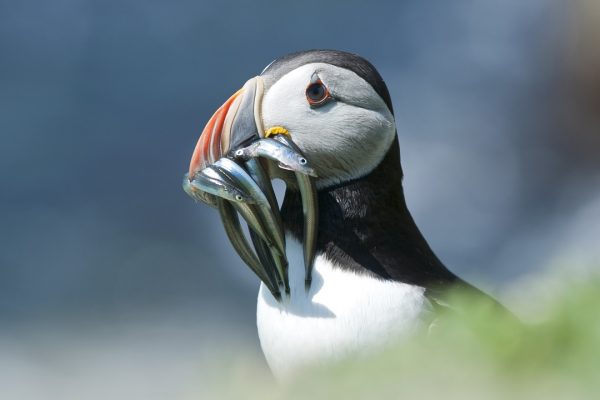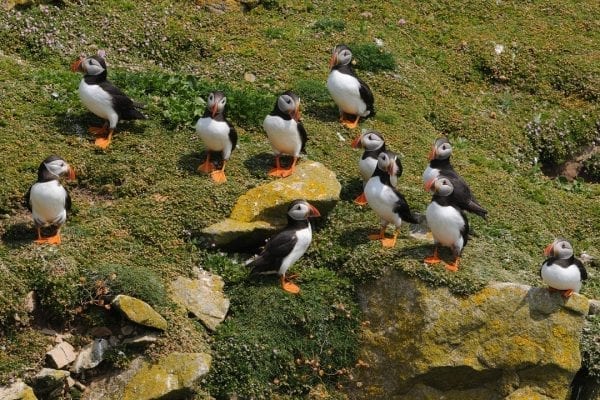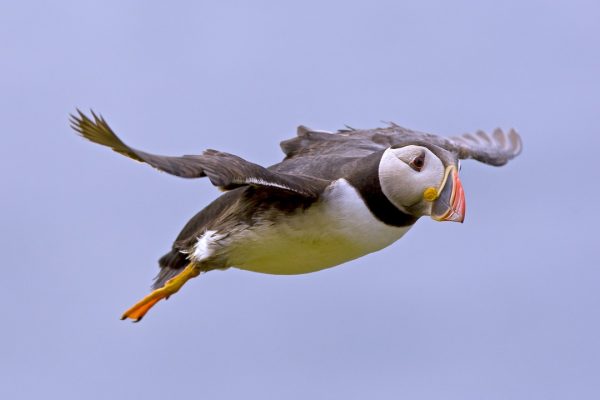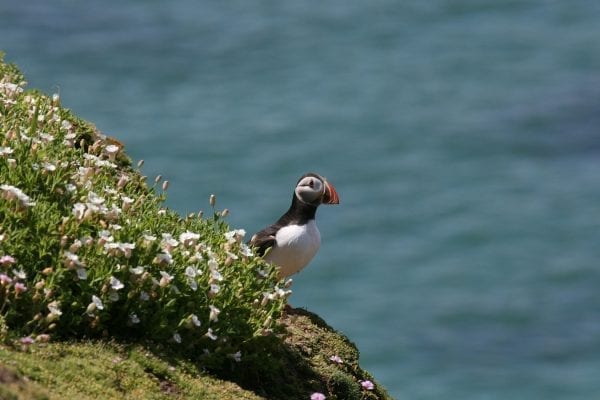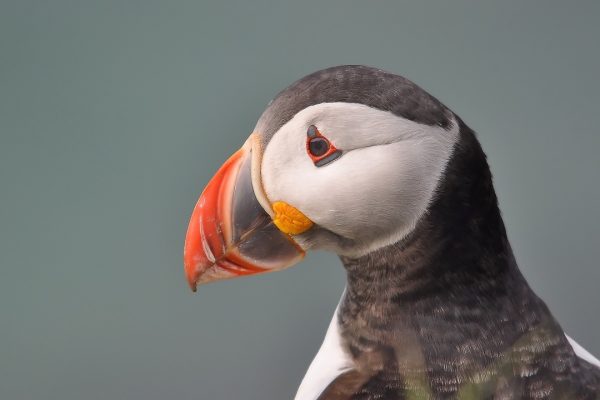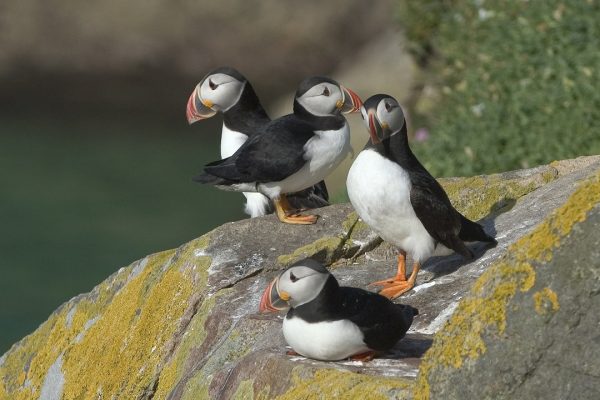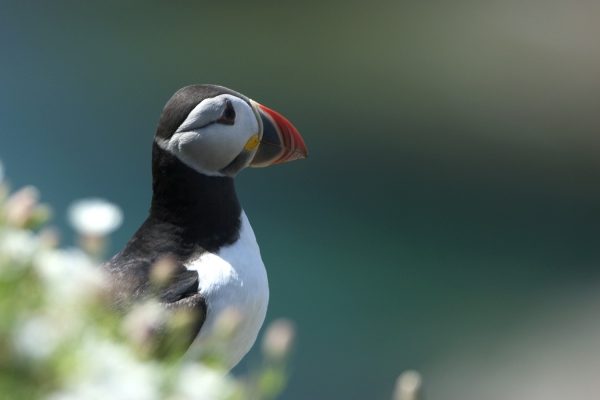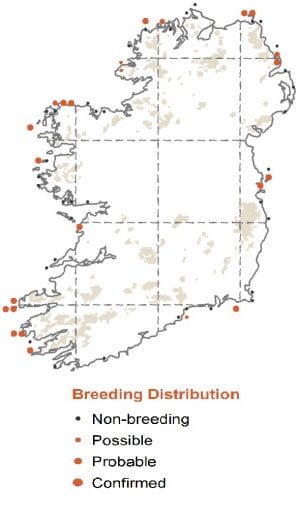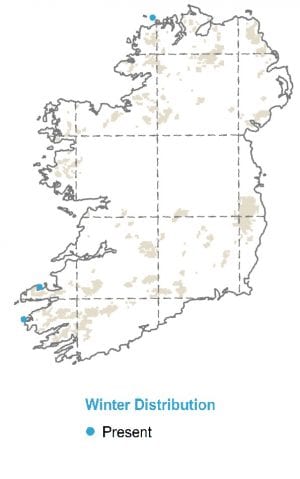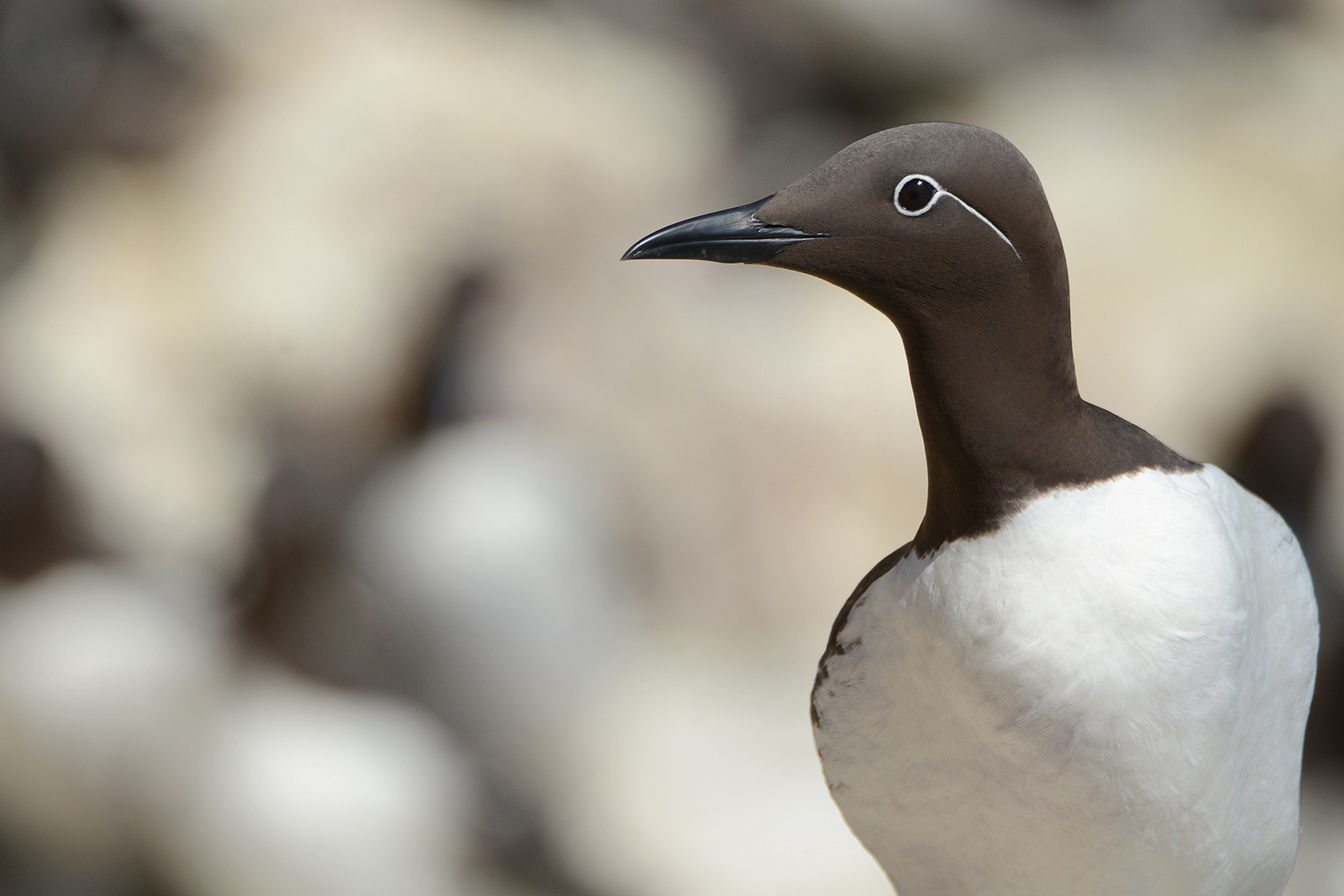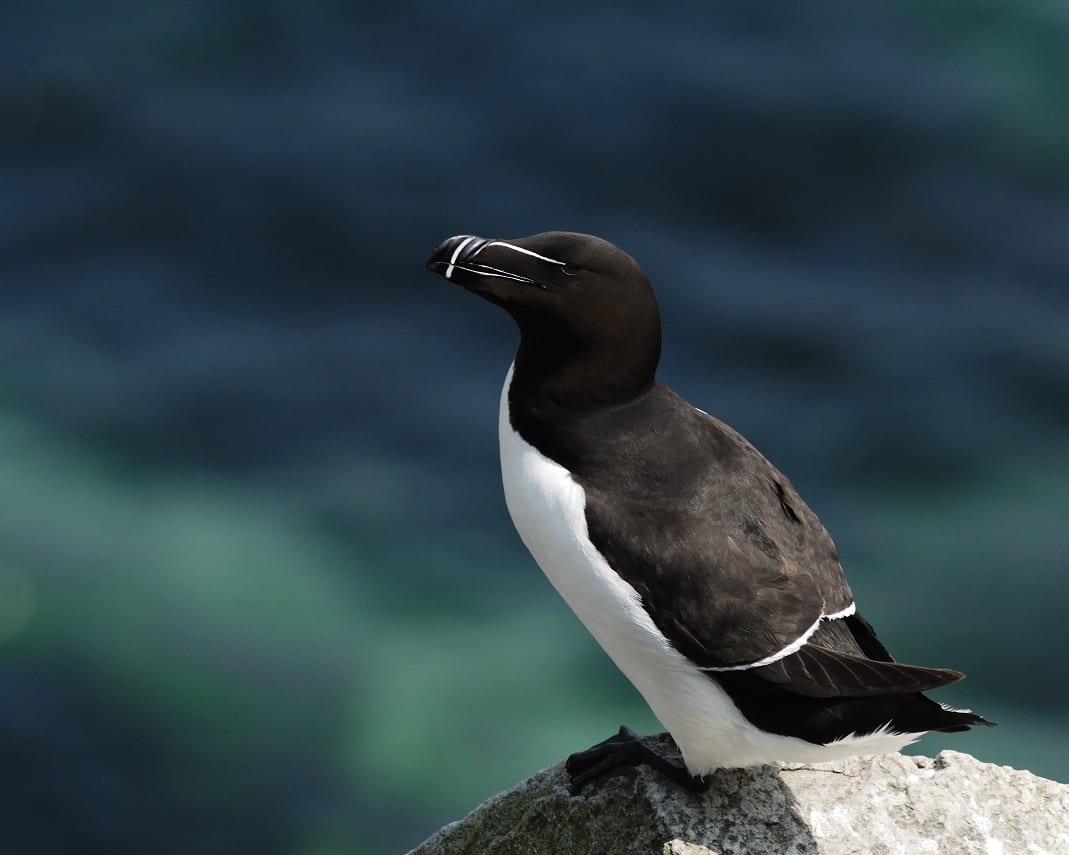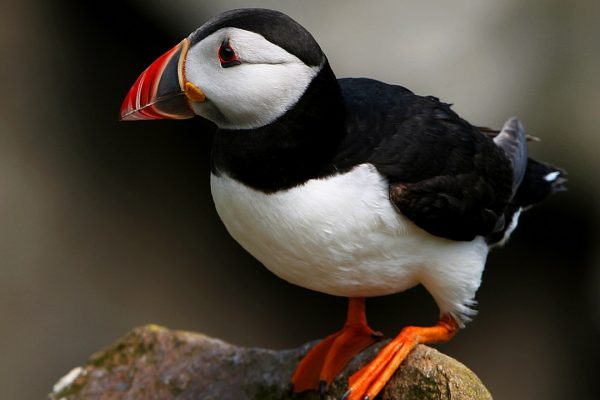
Puffin
| Irish Name: | Puifín |
| Scientific name: | Fratercula arctica |
| Bird Family: | Auks |
red
Conservation status
Conservation status
Status
Summer visitor from March to September to sea stacks and cliffs, mainly along the west coast of Ireland.
Identification
The smallest species of Auk in Ireland, a highly marine species which is only found on land in the breeding season. A black and white seabird, with black above and white below. In the breeding season the parrot like multi-coloured bill and large white patch on the face make adults distinctive and easily recognisable at close quarters. The bill is smaller on the adult in winter and much smaller on the juvenile. At a distance can be told from Guillemot by its small size, thicker body, larger, heavier head and darker underwing.
Voice
Deep grunting, mainly from the burrow.
Diet
Marine fish and crustaceans.
Breeding
Attends colonies from April and early August. Nests in colonies in burrows, or sometimes in boulder screes and in cracks in steep cliffs, rather like Razorbills and Black Guillemots. Will utilize rabbit burrows and will evict rabbits. Usually nests in areas that are safe from mammalian predators, for which reason it prefers off- shore islands.
Wintering
Winters far out to sea and not often seen outside of the breeding season.
Monitored by
Breeding seabirds are monitored through seabird surveys carried out every 15-20 years.
Blog posts about this bird
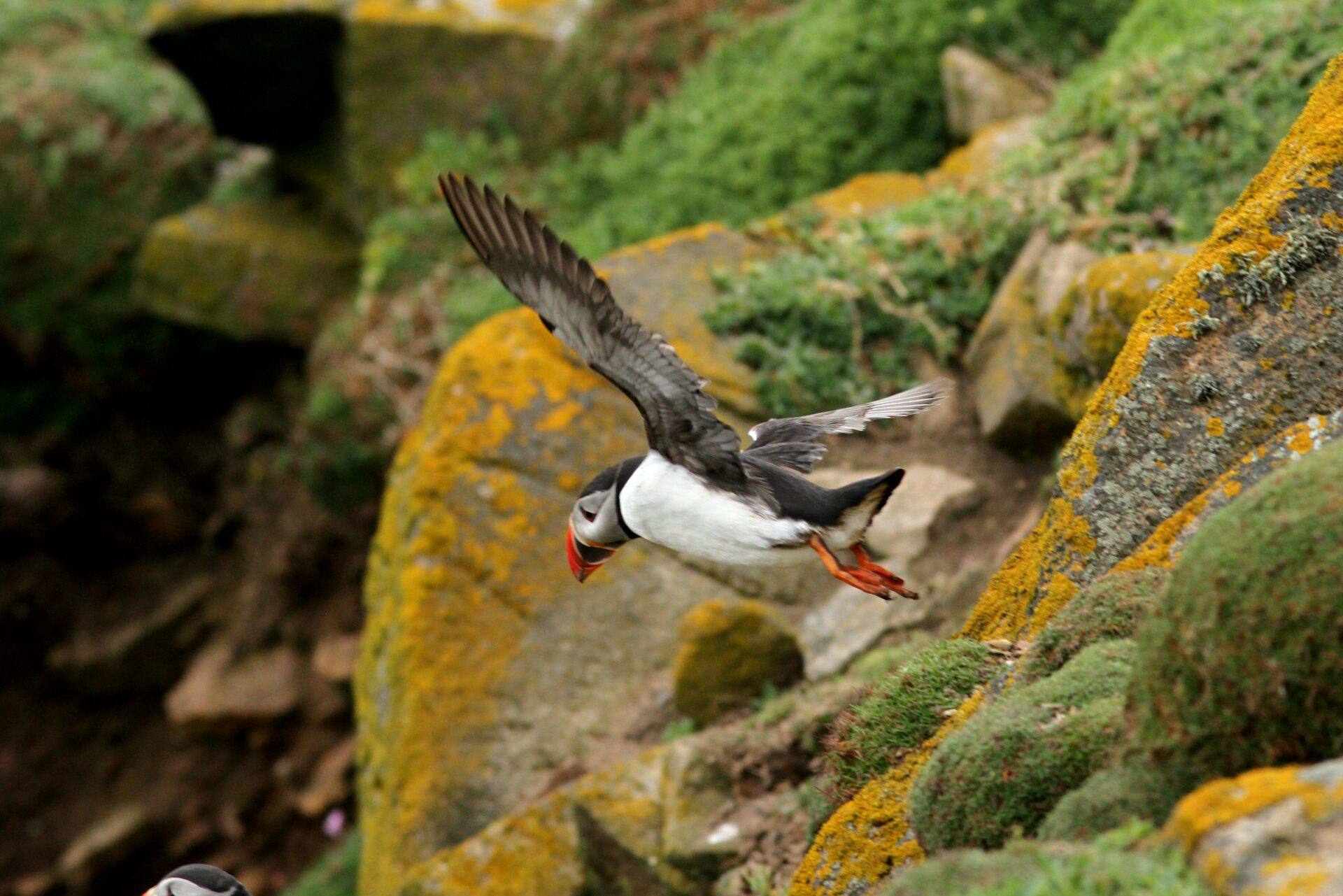
BirdWatch Ireland will march for end to fossil fuel era and greater protection for seabirds
On Saturday, 15th November, the Stop Climate Chaos coalition will assemble at 13:00 in Parnell Square, Dublin.
BirdWatch Ireland calls on its members to join it, and its human-sized Puffin, at the Dublin Climate Demonstration.
This Saturday, BirdWatch Ireland will join with thousands of people across the country who are participating the National Climate Demonstration, part of a worldwide day of action demanding an end the era of fossil fuels. The Dublin demonstration is organised by the Stop Climate Chaos coalition – which includes over 30 civil society organisations, including BirdWatch Ireland – and is supported by trade unions, student groups and local community organisations.
Seabirds in the Northern Hemisphere that feed on fish are the most impacted by climate change – coupled with the impact of overfishing. The reproductive success of these seabirds is already in decline. Research in the UK shows that 14 seabird species are at risk of decline or already in decline due to climate change (e.g., rising temperatures and severe weather events such as storms and floods). These include the iconic Atlantic Puffin (Fratercula arctica), which is predicted to lose up to 90% of its population across Britain and Ireland by 2050, should things continue down this path.
The Dublin demonstration is organised by the Stop Climate Chaos coalition – which includes over 30 civil society organisations, including BirdWatch Ireland – and is supported by trade unions, student groups and local community organisations.
Seabirds in the Northern Hemisphere that feed on fish are the most impacted by climate change – coupled with the impact of overfishing. The reproductive success of these seabirds is already in decline. Research in the UK shows that 14 seabird species are at risk of decline or already in decline due to climate change (e.g., rising temperatures and severe weather events such as storms and floods). These include the iconic Atlantic Puffin (Fratercula arctica), which is predicted to lose up to 90% of its population across Britain and Ireland by 2050, should things continue down this path.
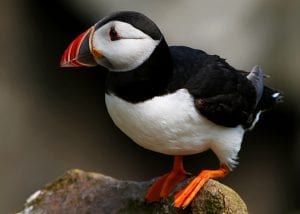 Andrew Kelly, CEO of BirdWatch Ireland says, “Ireland’s seabirds are the birds most threatened here by climate change. We have to do everything we can to end reliance on fossil fuels and speed up the roll-out of renewables, but in a way that doesn’t also impact seabirds. Ireland is very important globally for seabirds and we have to work hard to safeguard their future."
2024 was confirmed as the hottest year on record. The window for meaningful action is rapidly closing. Repeated IPCC reports have made clear that anything beyond 1.5°C poses catastrophic risks to human life, ecosystems and economic stability.
Throughout the world, communities are demanding faster and fairer climate action. With COP30 underway in Brazil, civil society groups and members of the public are calling time on corporate greed driving the climate crisis.
In 2025, BirdWatch Ireland published important areas for seabirds that require protection. Government still has not acted on designating further Special Protection Areas for seabirds or on progressing the Marine Protected Area legislation. Special Protection Areas in the open sea are critical to protect habitat for seabirds for all parts of their lifecycle and their designation and protection is a legal obligation on the State.
Oonagh Duggan, Head of Policy and Advocacy stated “Ireland's iconic Puffins are already Red-listed and in serious trouble. We stand to lose 90% of them by 2050 if we continue on our current emission-intensive path and don’t protect and restore areas at sea for them. BirdWatch Ireland has identified Important Bird Areas for Puffins and other seabirds and these must be designated by government as Special Protection Areas as soon as possible."
Andrew Kelly, CEO of BirdWatch Ireland says, “Ireland’s seabirds are the birds most threatened here by climate change. We have to do everything we can to end reliance on fossil fuels and speed up the roll-out of renewables, but in a way that doesn’t also impact seabirds. Ireland is very important globally for seabirds and we have to work hard to safeguard their future."
2024 was confirmed as the hottest year on record. The window for meaningful action is rapidly closing. Repeated IPCC reports have made clear that anything beyond 1.5°C poses catastrophic risks to human life, ecosystems and economic stability.
Throughout the world, communities are demanding faster and fairer climate action. With COP30 underway in Brazil, civil society groups and members of the public are calling time on corporate greed driving the climate crisis.
In 2025, BirdWatch Ireland published important areas for seabirds that require protection. Government still has not acted on designating further Special Protection Areas for seabirds or on progressing the Marine Protected Area legislation. Special Protection Areas in the open sea are critical to protect habitat for seabirds for all parts of their lifecycle and their designation and protection is a legal obligation on the State.
Oonagh Duggan, Head of Policy and Advocacy stated “Ireland's iconic Puffins are already Red-listed and in serious trouble. We stand to lose 90% of them by 2050 if we continue on our current emission-intensive path and don’t protect and restore areas at sea for them. BirdWatch Ireland has identified Important Bird Areas for Puffins and other seabirds and these must be designated by government as Special Protection Areas as soon as possible."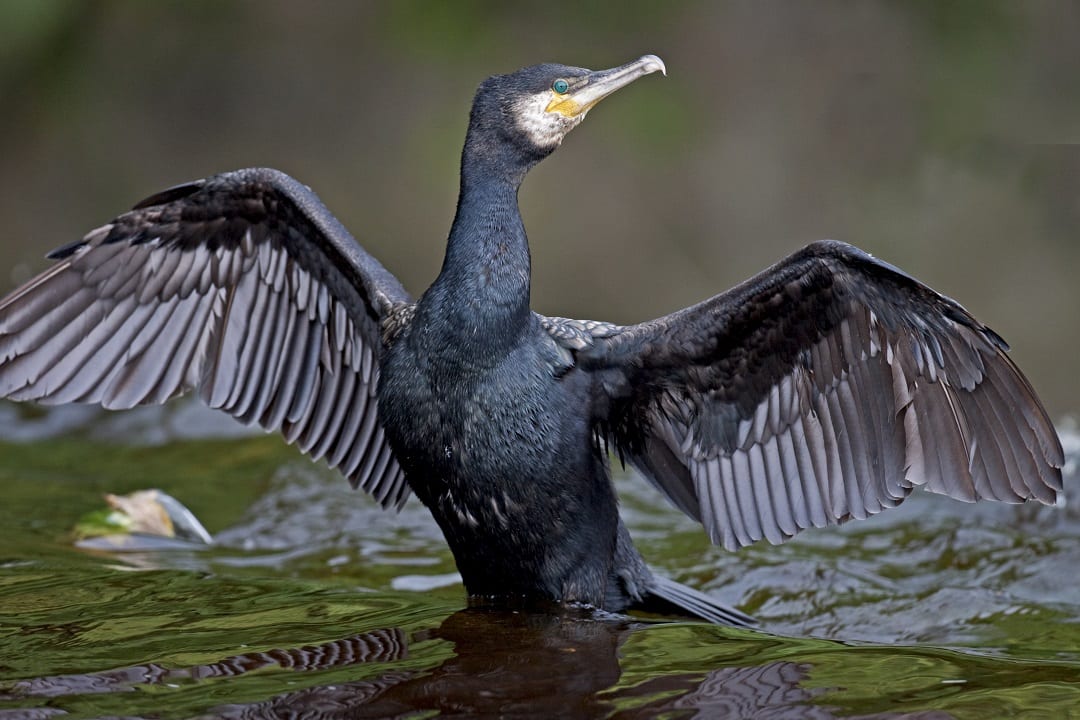
Seabirds of Europe: Report highlights declines and potential solutions
BirdLife International launched a report Seabirds of Europe: Current status, main threats and way forward this summer.
The report finds that over a third of seabirds (38%) in Europe have decreasing trends. One in three species are threatened with extinction according to the latest EU and European IUCN Red List assessments (2020 and 2021 respectively).
Among the most threatened European seabird species are the endemic Balearic Shearwater and the Zino’s Petrel, and species like the Atlantic Puffin are also singled out for their worryingly declining trends. By 2050, the Atlantic Puffin population is projected to decline by 89% across Britain and Ireland.
The seabird groups affected by the most threats overall are terns, medium-sized gulls, Grebes, Cormorants and Loons.


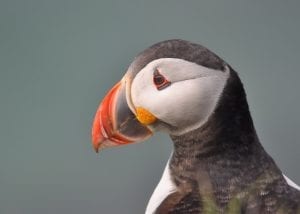
Photo: Puffin. Rónán McLaughlin
What is driving the decline of seabirds? Overfishing, invasive alien species and climate change are the main drivers of decline among seabirds during the breeding season. Climate change impacts, including temperature rise and severe stormy weather, cause increasing harm to seabirds. Other reasons for declines in the EU region include overfishing, hunting, pollution, energy infrastructure, recreational activities, and avian influenza. As the list of threats demonstrates, most seabirds are not just affected by one threat throughout their life cycle, but by multiple threats. The cumulative impact of all these threats therefore needs to be considered when assessing the pressures these animals face and the solutions to holistically conserve them. As part of their lifecycle, seabirds spend time both on land and at sea, and they face some threats only during certain seasons. Threats occurring on land will predominantly affect seabirds during the breeding season, whereas marine threats may affect seabirds throughout the entire year. In Europe, threats occurring in the marine environment have a higher impact on seabirds than threats occurring on land. Pressures from Invasive Alien Species (e.g. predation by rats) is an example of a threat that occurs on land and mostly during the breeding season. Invasives can negatively impact the breeding success of seabird populations, especially on chick survival and egg hatching. Recreational activities are a constant pressure during the entire year for coastal species, such as gulls and terns. For example, beach tourism can cause disturbance to birds as they use extra energy to find new resting and nesting places.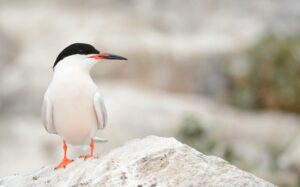
Photo: Roseate Tern. Brian Burke.
Finding solutions Political leaders and decisionmakers already have the solutions to protect vulnerable seabirds, marine species and habitats. The report takes a deep dive into some of them, including:- Eradicating and controlling invasive species
- Reducing bycatch through different types of fishing gear
- Fully implementing the EU Common Fisheries Policy to tackle overfishing
- Establishing Marine Protected Areas (MPAs)

